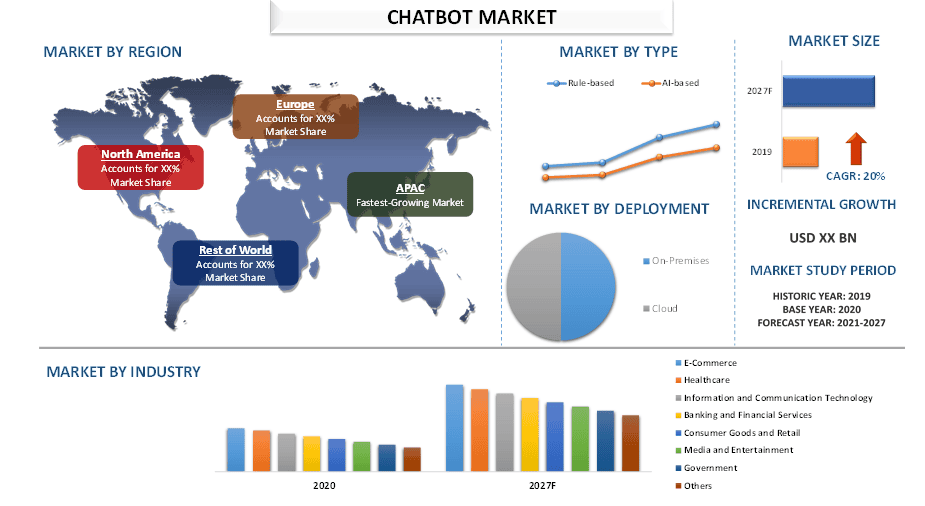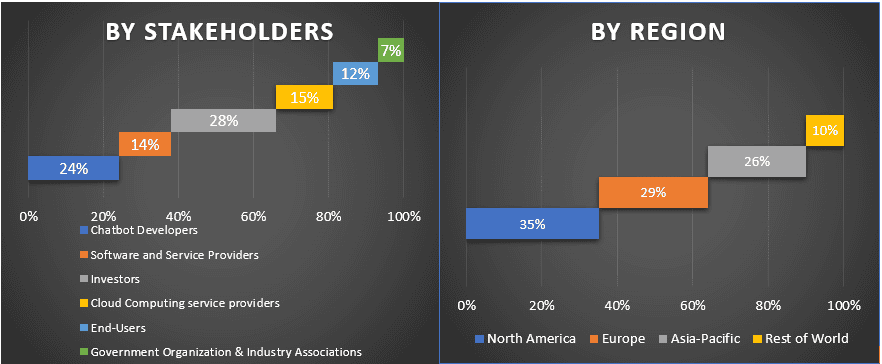- Home
- About Us
- Industry
- Services
- Reading
- Contact Us
Chatbot Market: Current Analysis and Forecast (2021-2027)
Emphasis on Components (Solutions and Services); Type (Rule-based and AI-based); Organization size (Large Enterprises and SMEs); Deployment (On-premises and Cloud); Application (AI and IT, Automotive, Banking, Healthcare, and Others); Industry (E-Commerce, Healthcare, Information and Communication Technology, Banking and Financial Services, Consumer Goods and Retail, Media and Entertainment, Government, and Others); and Region and Country

The global chatbot market is likely to showcase a growth of around 23% during the forecast period. Key factors influencing the growth of the chatbot market are technological advancements and 24*7 customer assistance at lower operational costs. With the increasing internet and mobile penetration rate in most countries, the demand for customer support is also increasing according to some data, more than 3.5 billion people are using smartphones and this number is increasing hence the demand for faster customer support is also increasing. Chatbots have the ability to provide quick customer support. Furthermore, chatbots are also able to handle thousands and even millions of customers at once. They are available 24*7, they can provide instant answers to customer queries. Moreover, chatbots can be programmed, for multiple languages also, so can provide answers in different languages and become multilingual.
Insights Presented in the Report
“Amongst type, Rule-based category held prominent market share in 2020”
On the basis of type, the chatbot market is segmented into rule-based and AI-based. Among these, the rule-based segment held a significant share in the global chatbot market. Moreover, rule-based chatbots are well-written programs that use a series of defined rules. These rules are the basis for the types of problems the chatbot is familiar with and can deliver solutions for. Rule-based chatbots can use very simple or complicated rules. They can’t, however, answer any questions outside of the defined rules. Further on, it is simpler to create a rule-based chatbot than an AI-based chatbot. This is because rule-based chatbots give answers to the client’s questions from a set of predefined rules created from known scenarios. However, AI-based chatbots are expected to witness significant growth during the forecast period due to the automation of frequently performed tasks performed frequently at specific times.
“Amongst deployment, on-premises category held prominent market share in 2020”
On the basis of deployment, the chatbot market is categorized into on-premises and cloud. Among these on-premises deployment held a significant share of the revenue in the chatbot market in 2020 and will continue to grow at a steady rate during the forecast period. to the data control, customizability, and cost-saving features provided by the on-premises deployment. Moreover, in on-premises deployment, resources and codes are deployed locally.
“Amongst industry, e-commerce category held prominent market share in 2020”
On the basis of industry, the chatbot market is categorized into e-commerce, healthcare, information and communication technology, banking and financial services, consumer goods and retail, media and entertainment, government, and others. The e-commerce segment held a prominent share of the revenue in the chatbot market in 2020 due to the quick queries solution and error-free solution abilities of chatbots. E-Commerce chatbots are rule-based or artificially intelligent programs that online retailer can deploy to connect with their customers throughout the customer journey on the platform. E-Commerce stores can use these chatbots to answer basic or advanced questions about their products on the website or even on messaging platforms like WhatsApp, Instagram, Facebook Messenger, and others. Moreover, bots allow retailers to send content and promotional messages on the touchpoints customers spend the most time on, it creates a powerful omnichannel engagement strategy.
“North America held the prominent share in the market in 2020”
North America accounted for the prominent market share in 2020 and will continue to hold a prominent share in the chatbot market owing to the trend of being an early adopter of the latest technologies and the rising mobile penetration rate. Moreover, being a major hub for startups in the chatbot industry, it accounted for a prominent share of the market in 2020. Many large enterprises are increasingly adopting chatbots in their routine customer service activities. The adequate growth possibilities of chatbots in various regions can be attributed to the significant benefits that it offers to enterprises, such as cost reduction, customer satisfaction, and enhanced operating efficiency. Furthermore, a significant rise in messaging services, and development in natural language processing (NLP) and AI technologies are also expected to play an important role in the growth of the chatbot industry. Further on, highly conversational chatbot apps allow businesses to create a smooth journey for their customers on the platform, as they interact over a wide variety of digital channels and devices.
Some of the major players operating in the market include Amazon.com Inc., [24]7.ai, Google LLC, International Business Machines Corporation, Yellow Messenger, Gupshup, Aivo, Conversica Inc., Nuance Communications Inc., Kevit.io among others.
Reasons to buy this report:
- The study includes market sizing and forecasting analysis validated by authenticated key industry experts
- The report presents a quick review of overall industry performance at one glance
- The report covers an in-depth analysis of prominent industry peers with a primary focus on key business financials, product portfolio, expansion strategies, and recent developments
- Detailed examination of drivers, restraints, key trends, and opportunities prevailing in the industry
- The study comprehensively covers the market across different segments
- Deep dive country-level analysis of the industry
Customization Options:
The global chatbot market can further be customized as per the requirement or any other market segment. Besides this, UMI understands that you may have your own business needs, hence feel free to connect with us to get a report that completely suits your requirements.
Table of Content
Analyzing the historical market, estimating the current market, and forecasting the future market of chatbot, three major steps are undertaken to create and analyze its adoption across the globe. Exhaustive secondary research was conducted to collect the historical market numbers and estimate the current market size. Secondly, to validate these insights, numerous findings and assumptions were taken into consideration. Moreover, exhaustive primary interviews were also conducted, with industry experts across the value chain of the chatbot industry. Post assumption and validation of market numbers through primary interviews, we employed a bottom-up approach to forecast the complete market size. Thereafter, market breakdown and data triangulation methods were adopted to estimate and analyze the market size of segments and sub-segments of the industry pertains to. Detailed methodology is explained below:
Seek More Details About Research Methodology
Analysis of Historical Market Size
Step 1: In-Depth Study of Secondary Sources:
Detail secondary study was conducted to obtain the historical market size of chatbot through company internal sources such as annual reports & financial statements, performance presentations, press releases, etc., and external sources including journals, news & articles, government publications, competitor publications, sector reports, third-party database, and other credible publications.
Step 2: Market Segmentation:
After obtaining the historical market size of the chatbot market, we conducted a detailed secondary analysis to gather current market insights and share for different segments & sub-segments for major regions. The major segment is included in the report by components, type, organization size, deployment, application, and industry. Further regional and country-level analyses were conducted to evaluate the overall adoption of chatbots globally.
Step 3: Factor Analysis:
After acquiring the historical market size of different segments and sub-segments, we conducted a detailed factor analysis to estimate the current market size of chatbots. Further, we conducted factor analysis using dependent and independent variables such as technological advancements and 24*7 customer assistance at lower operational costs. A thorough analysis was conducted for demand and supply-side scenarios considering an increasing investment, top partnerships, mergers and acquisitions, business expansion, and product launches in the chatbot industry.
Current Market Size Estimate & Forecast
Current Market Sizing: Based on actionable insights from the above 3 steps, we arrived at the current market size, key players in the global chatbot market, and market shares of each segment. All the required percentage shares split, and market breakdowns were determined using the above-mentioned secondary approach and were verified through primary interviews.
Estimation & Forecasting: For market estimation and forecast, weights were assigned to different factors including drivers & trends, restraints, and opportunities available for the stakeholders. After analyzing these factors, relevant forecasting techniques i.e., the bottom-up approach were applied to arrive at the market forecast to 2027 for different segments and subsegments across the major regions globally. The research methodology adopted to estimate the market size encompasses:
- The industry’s market size, in terms of value (US$) and the adoption rate of chatbots across the major markets
- All percentage shares, splits, and breakdowns of market segments and sub-segments
- Key players in the chatbot market. Also, the growth strategies adopted by these players to compete in the fast-growing market.
Market Size and Share Validation
Primary Research: In-depth interviews were conducted with the Key Opinion Leaders (KOLs) including Top Level Executives (CXO/VPs, Sales Head, Marketing Head, Operational Head, Regional Head, Country Head, etc.) across major regions. Primary research findings were then summarized, and statistical analysis was performed to prove the stated hypothesis. Inputs from primary research were consolidated with secondary findings, hence turning information into actionable insights.
Split of Primary Participants by Stakeholders and Regions

Market Engineering
The data triangulation technique was employed to complete the overall market estimation and to arrive at precise statistical numbers for each segment and sub-segment of the global chatbot market. Data was split into several segments & sub-segments post studying various parameters and trends in the area of components, type, organization size, deployment, application, and industry.
The main objective of the Chatbot market study
The current & future market trends of chatbots were pinpointed in the study. Investors can gain strategic insights to base their discretion for investments on the qualitative and quantitative analysis performed in the study. Current and future market trends would determine the overall attractiveness of the market at a country level, providing a platform for the industrial participant to exploit the untapped market to benefit as a first-mover advantage. Other quantitative goals of the studies include:
- Analyze the current and forecast market size of Chatbot in terms of value (US$). Also, analyze the current and forecast market size of different segments and sub-segments
- Segment in the study include the area of components, type, organization size, deployment, application, and industry
- Defined analysis of the regulatory framework for the Chatbot industry
- Analyze the value chain involved with the presence of various intermediaries, along with analyzing customer and competitor behaviors of the industry
- Analyze the current and forecast market size of chatbot for the major countries
- Major regions/countries analyzed in the report include North America (US, Canada, Rest of North America), Europe (Germany, UK, France, Italy, Spain, Rest of Europe), Asia-Pacific (China, Japan, India, Australia, Rest of Asia-Pacific), and Rest of World
- Company profiles of the chatbot market players and the growth strategies adopted by them to sustain in the growing market
Deep dive country-level analysis of the industry
Related Reports
Customers who bought this item also bought










